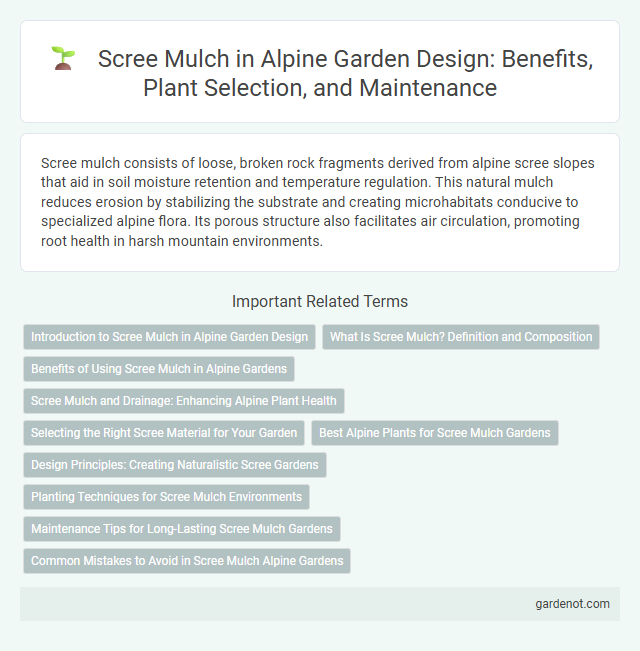Scree mulch consists of loose, broken rock fragments derived from alpine scree slopes that aid in soil moisture retention and temperature regulation. This natural mulch reduces erosion by stabilizing the substrate and creating microhabitats conducive to specialized alpine flora. Its porous structure also facilitates air circulation, promoting root health in harsh mountain environments.
Introduction to Scree Mulch in Alpine Garden Design
Scree mulch in alpine garden design replicates natural rocky debris, promoting soil drainage and root protection vital for alpine plants. This mulch type consists of small, angular stones that prevent soil erosion and retain moisture, mimicking the scree slopes found in mountainous regions. Using scree mulch enhances plant stability and overall garden resilience in harsh, high-altitude environments.
What Is Scree Mulch? Definition and Composition
Scree mulch consists of small, loose stones or gravel fragments derived from the natural weathering and fragmentation of alpine scree slopes. It serves as a protective ground cover promoting soil stability and moisture retention in harsh mountain environments. Comprised primarily of mineral rock particles, scree mulch mimics the natural substrate found in alpine ecosystems, supporting specialized plant communities adapted to these rocky conditions.
Benefits of Using Scree Mulch in Alpine Gardens
Scree mulch enhances alpine garden soil by improving drainage and mimicking natural mountainous conditions, which supports drought-tolerant plant growth. Its coarse texture minimizes erosion and retains moisture without waterlogging delicate roots, promoting healthier alpine species. Using scree mulch also suppresses weed growth, reducing competition and maintaining a clean, visually appealing landscape.
Scree Mulch and Drainage: Enhancing Alpine Plant Health
Scree mulch is an essential component in alpine gardening, providing excellent drainage that mimics natural scree slopes and prevents waterlogging. Its coarse, rocky texture promotes rapid water percolation, reducing root rot and fostering robust root systems for alpine plants. By enhancing soil aeration and moisture regulation, scree mulch significantly contributes to the overall health and resilience of alpine vegetation.
Selecting the Right Scree Material for Your Garden
Choosing the right scree material for your garden involves evaluating particle size, mineral composition, and drainage capacity to replicate authentic alpine scree conditions. Opt for angular, well-draining stones such as granite or quartzite to promote root aeration and prevent waterlogging. Incorporating a mixture of coarse and fine scree enhances soil stability while supporting native alpine plant growth.
Best Alpine Plants for Scree Mulch Gardens
Alpine scree mulch gardens thrive with plants like Saxifraga, Androsace, and Sedum species, which are adapted to well-drained, rocky soils and mimic natural scree conditions. These hardy perennials offer exceptional drought tolerance and low maintenance, making them ideal for alpine scree settings. Incorporating cushion-forming plants such as Silene acaulis enhances soil stability and moisture retention within scree mulch environments.
Design Principles: Creating Naturalistic Scree Gardens
Scree mulch mimics the natural alpine scree environment by using coarse, well-draining materials like gravel and crushed stone that promote root aeration and reduce water retention. Design principles for naturalistic scree gardens emphasize layering diverse rock sizes to replicate varied scree textures, combined with drought-tolerant alpine plants adapted to harsh conditions and minimal soil nutrients. Strategic placement of mulch enhances microclimates that support plant survival and encourages natural succession patterns in alpine garden settings.
Planting Techniques for Scree Mulch Environments
Scree mulch requires precise planting techniques that emphasize deep root anchoring to prevent erosion on loose rocky substrates. Selecting drought-tolerant alpine species like Sedum and Saxifraga maximizes survival while enhancing soil stability. Integrating micro-habitats such as crevices within the scree mulch promotes moisture retention and root establishment.
Maintenance Tips for Long-Lasting Scree Mulch Gardens
Regularly inspect scree mulch for debris accumulation and remove fallen leaves and organic matter to prevent decay and fungal growth. Maintain proper drainage by ensuring scree particles are evenly distributed and replenished annually to avoid soil erosion and compaction. Use a lightweight rake or hand tools to gently aerate the scree mulch, promoting healthy root systems for alpine plants in rocky garden environments.
Common Mistakes to Avoid in Scree Mulch Alpine Gardens
Using inappropriate mulch materials in alpine scree gardens can lead to poor drainage and root rot, critical issues for drought-tolerant alpine plants. Over-mulching with thick layers traps moisture and hinders airflow, creating an environment conducive to fungal diseases. Selecting coarse, inorganic mulches like gravel or crushed stone helps maintain the natural rocky appearance while preventing these common mistakes in scree mulch management.
Scree mulch Infographic

 gardenot.com
gardenot.com